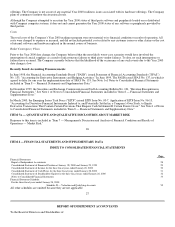Dell 1999 Annual Report Download - page 25
Download and view the complete annual report
Please find page 25 of the 1999 Dell annual report below. You can navigate through the pages in the report by either clicking on the pages listed below, or by using the keyword search tool below to find specific information within the annual report.
Advertising Costs — Advertising costs are charged to expense as incurred. Advertising expenses for fiscal years 2000, 1999, and 1998
were $325 million, $199 million, and $137 million, respectively.
Stock-Based Compensation — The Company applies the intrinsic value method in accounting for its stock option and stock purchase
plans. Accordingly, no compensation expense has been recognized for options granted with an exercise price equal to market value at
the date of grant or in connection with the employee stock purchase plan.
Capitalized Software — During fiscal year 2000, the Company adopted the American Institute of Certified Public Accountants
Statement of Position ("SOP") 98-1, "Accounting for the Costs of Computer Software Developed or Obtained for Internal Use." The
Company capitalizes eligible software development costs incurred subsequent to the completion of the preliminary project stage. Prior
to capitalization, policy requires that the project has been authorized by management and it is probable that the project will be
completed and the software will be used to perform the function intended. After all substantial testing and deployment is completed
and software is ready for its intended use, development costs are amortized over the shorter of the expected useful life of the software
or five years. The impact on both the Consolidated Statement of Financial Position and on
34
the Consolidated Statement of Income as of January 28, 2000 is not material. Prior to adoption of SOP 98-1, the Company expensed
these costs as incurred.
Income Taxes — The provision for income taxes is based on income before taxes as reported in the accompanying Consolidated
Statement of Income. Deferred tax assets and liabilities are determined based on the difference between the financial statement and tax
basis of assets and liabilities using enacted tax rates in effect for the year in which the differences are expected to reverse.
Earnings Per Common Share — Basic earnings per share is based on the weighted effect of all common shares issued and
outstanding, and is calculated by dividing net income by the weighted average shares outstanding during the period. Diluted earnings
per share is calculated by dividing net income by the weighted average number of common shares used in the basic earnings per share
calculation plus the number of common shares that would be issued assuming conversion of all potentially dilutive common shares
outstanding. The following table sets forth the computation of basic and diluted earnings per share for each of the past three fiscal
years:
Fiscal Year Ended
January 28, January 29, February 1,
2000 1999 1998
(in millions, except per share data)
Net income $ 1,666 $ 1,460 $ 944
Weighted average shares outstanding:
Basic 2,536 2,531 2,631
Employee stock options and other 192 241 321
Diluted 2,728 2,772 2,952
Earnings per common share:
Basic $ 0.66 $ 0.58 $ 0.36
Diluted $ 0.61 $ 0.53 $ 0.32
Comprehensive Income — The Company's comprehensive income is comprised of net income, foreign currency translation
adjustments and unrealized gains and losses on investments held as available-for-sale investments.
Segment Information — The Company discloses segment information in accordance with SFAS No. 131 which uses the Management
approach to determine reportable segments.
Recently Issued Accounting Pronouncements — In June 1998, the Financial Accounting Standards Board ("FASB") issued SFAS
No. 133, "Accounting for Derivative Instruments and Hedging Activities," which establishes accounting and reporting standards for
derivative instruments and hedging activities. SFAS No. 133 requires that an entity recognize all derivatives as either assets or
liabilities in the statement of financial position and measure those instruments at fair value. In June 1999, The FASB issued Statement
No. 137, in which it agreed to defer for one year the implementation date of SFAS No. 133. SFAS No. 133, as amended, is effective
for all fiscal years beginning after June 15, 2000. The Company is assessing the impact of SFAS No. 133 on its consolidated financial
statements.
In December 1999, the Securities and Exchange Commission issued Staff Accounting Bulletin No. 101 ("SAB 101"), "Revenue
Recognition in Financial Statements." SAB 101 provides guidance on applying generally accepted accounting principles to revenue
recognition in financial statements. The Company is currently assessing the impact of SAB 101 on its consolidated financial
statements, and believes that the effect, if any, will not be material to the Company's operating results.
In March 2000, the Emerging Issues Task Force ("EITF") issued EITF Issue No. 00-7, "Application of EITF Issue No. 96-13,
Accounting for Derivative Financial Instruments Indexed to, and Potentially Settled in, a Company's Own Stock, to Equity Derivative
Transactions That Contain Certain Provisions That Require Cash Settlement If Certain Events Occur." EITF Issue No. 96-13
35
























